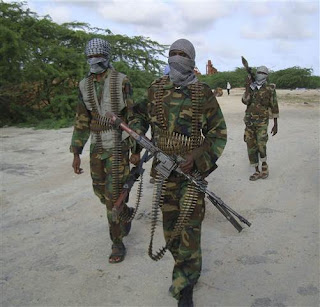 |
Somali Women Praying
|
Somalis belong to the Sunni branch of
Islam, to which the vast majority of the world’s Muslims belong. Somali's
consider themselves 100 percent Muslims although less than 1 percent of ethnic
Somalis are Christians. Those families are descendants of whose grandparents
were brought up by Catholic missionaries. In regards to the denominations of
Islam, The Sunni’s believe Muslims should elect their rulers, while the Shia
believe that successions should follow along with the lines of descent from the
prophet’s family. In the north is a society organized to implement Muslim
precepts in which no distinction exists between the secular and the religious
spheres. In the South where religious pioneers were at one time a vital part of
the social and political structure, the government instituted legal changes
that some religious figures saw as contrary to Islamic precepts regime reacted
sharply to criticism, executing some of the protesters
 |
Sunni Somali Men participating in Mosque
|
 |
Artistic rendition of Jinn
|
According to the Qur'an, God created two apparently
parallel species, man, and jinn. The man was created from clay and jinn was
created from fire. The jinn is endowed with reason and responsibility but is
more prone to evil than man. Physical in nature, having the capacity to
collaborate in a material way with individuals and articles and similarly be
followed up on. The jinn, people, and heavenly attendants make up the three
known insightful manifestations of God. As human beings, the jinn can be good,
evil, or neutrally benevolent and hence have free will like humans.1 Somalia
also maintains folklore in a modified form of Islam. Secular leaders and their
clan genealogies have the power to bless and harm others with what is known as
Baraka; Baraka is considered a gift from God to the founders and heads. These
leaders practice wadad; a form of folk astronomy based on stellar movements and
related to seasonal changes. Its primary objective is to signal the times for
migration, but it may also be used to set the dates of rituals that are
specifically Somali. This folk knowledge is also used in ritual methods of
healing and averting misfortune, as well as for divination.2
 |
| http://evolvingcreation.com/wp-content/uploads/2012/10/Creation.jpg |
 |
Holy Quaran
|
Islam was in no way, shape or form the first religion
to have reached the Somali shores from the Middle East. Somali people, believed
to have migrants of Kush, an ancient Nubian kingdom situated on the confluences
what is now the Republic of Sudan, practiced a faith in and worship of a
solitary god while likewise having confidence in the presence or conceivable
presence of different gods. The focal god was the waaq (sky god), and also
spirits of two sorts: great spirits called the ayaan or ayaana, and malicious
spirits called the busho or bushi.However, since no indigenous spiritual group
has survived, beliefs can therefore only be hypothesized by the terms regarding
the aforementioned deities in Somali culture.
 |
Horn of Africa, Muslim Demographic
|
 |
Al-Shabaab Soldiers
|
Since northern Africa is heavily Muslim and southern
Africa is heavily Christian, the great meeting place is in the middle, a
4,000-mile swath from Somalia in the east to Senegal in the west.3 Al-Shabaab,
a Somali-based Islamist militant
group with affiliations to Al-Queda, seize
anyone suspected of converting to Christianity. Churches have been destroyed
and congregations targeted to an extent that the small percentage of Christians
are forced to worship in secret throughout the country. The following
excerpt is taken from a recent article from Prophecy News Watch: Christian Converts
from Islam Face Beheading in Somalia; “On March 4th of 2014, Islamic
al-Shabaab radicals in the port town of Barawa in southeastern Somlia learned
that two women had returned from Kenya and they suspected the cousins of being
Christian. They seized 41-year-old Sdia Ali Omar and 35-year-old Osman
Mohamoud Moge and brought them to the town square. As witnesses have
reported, Mrs. Omar's two daughters, ages eight and fifteen, were forced to
watch as the militants pronounced their sentence, "We know these two
people are Christians who recently came back from Kenya; we want to wipe out
any underground Christians living inside jihadist areas. The daughters screamed
for villagers to stop the men as their mother and aunt were beheaded, but no
one dared to intervene. The girls were taken to safety by a relative for fear
that al-Shabaab would watch them and come for them next and they are now both
living in hiding.”4 Similar stories resonate throughout the continent
demonstrating Christian persecution and judgement.
 |
Al-Shabaab massacre of Kenyan Christians
|
 |
| https://themuslimissue.wordpress.com/2013/12/23/muslims-massacre-1000-christians-in-central-africa/ |
Citations
3.
http://www.pewforum.org/2010/04/15/executive-summary-islam-and-christianity-in-sub-saharan-africa/
Bibliography
ABDULLAHI, MOHAMED DIRIYE, and Mohamed Diriye
Abdullahi. 2004. "Somalia: Pastoralism, Islam, Commerce, Expansion: To
1800". In Encyclopedia of African History, edited by Kevin Shillington.
London: Routledge. Accessed February 3, 2017. http://ezproxy.liberty.edu:2048/login?url=https://literati.credoreference.com/content/entry/routafricanhistory/somalia_pastoralism_islam_commerce_expansion_to_1800/0
Britannica
Academic, s.v. "Al-Shabaab," accessed February 3, 2017, http://academic.eb.com.ezproxy.liberty.edu/levels/collegiate/article/574303.
Diriye Abdullahi, Mohamed. Culture and Customs
of Somalia. Westport, Conn: Greenwood, 2001. eBook Collection
(EBSCOhost), EBSCOhost. Accessed February 3, 2017. 55-67 http://web.b.ebscohost.com.ezproxy.liberty.edu/ehost/ebookviewer/ebook/bmxlYmtfXzEyNzk2OF9fQU41?sid=b621bbcb-e9ed-45cb-b37c-120feaf49b22@sessionmgr102&vid=0&format=EB&rid=1
Helen Chapin
Metz, ed. Somalia: A Country Study. Washington: GPO for the Library of
Congress, 1992. Accessed February 3, 2017. http://countrystudies.us/somalia/
No comments:
Post a Comment